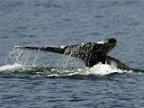Sonar
Navy agrees to low-frequency sonar restrictions for mammals’ sake
 The U.S. District Court in San Francisco approved on Tuesday an agreement between the U.S. Navy and conservation groups regarding the use of low-frequency sonar for training. The two sides came to the conclusion that in order to limit the impact of sonar use on whales and other marine mammals, the Navy should only use it in specific training areas near Hawaii and western Pacific Ocean.
The U.S. District Court in San Francisco approved on Tuesday an agreement between the U.S. Navy and conservation groups regarding the use of low-frequency sonar for training. The two sides came to the conclusion that in order to limit the impact of sonar use on whales and other marine mammals, the Navy should only use it in specific training areas near Hawaii and western Pacific Ocean.
This is just a small part of the ongoing legal battle between the Bush administration and organizations trying to protect marine mammals. The Navy’s low-frequency active sonar is used to detect enemy submarines at significant distances, and the Bush administration has been very supportive for an unrestricted use of the sonar for security reasons.
However, according to the Natural Resources Defense Council (NRDC), a plaintiff in the case, the LFA system capable of disorienting whales 300 miles away. Furthermore, the NRDC explained that the LFA system could be detected across entire oceans, and that the Navy’s proposal to deploy the system in 70 percent of the world’s oceans would be not only illegal, but also a mass crime for dolphins and whales.
According to a permit issued by the National Marine Fisheries Service last year, the deployment of a sonar system around the globe was completely permitted, despite environmental concerns and federal laws, such as the Marine Mammal Protection Act and the National Environmental Policy Act.
“We don’t have to choose between national security and protecting the environment,” said Michael Jasny, senior policy analyst with NRDC. “Today’s agreement maintains the Navy’s ability to test and train, while shielding whales and other vulnerable species from harmful underwater noise.”
According to the agreement, low-frequency sonar use will be limited to certain areas of the North Pacific Ocean. In Hawaii, LFA training will now be prohibited near the Hawaii Humpback Whale National Marine Sanctuary or the Papahanaumokuakea Marine National Monument, and will be restricted to 50 nautical miles of the main islands.
This agreement however doesn’t settle another matter, regarding the use of mid-frequency sonar off the coast of California. Earlier this year, a federal judge ruled in favor of limiting the use of mid-frequency sonar within 12 miles of Southern California for the protection of whales and dolphins. At the same time, the judge rejected President Bush’s concerns on national security, saying that as long as there is no immediate threat, the Navy must submit to the order.
In June, the U.S. Supreme Court agreed to review the Navy’s demands to lift restrictions on their ability to train off the coast of California. According to environmental groups, this particular type of sonar has been linked to panicked and disoriented behavior from whales and dolphins, and sometimes even to their death.
The National Environmental Policy Act instituted on January 3rd was meant to avoid the use of mid-frequency sonar within the migrating corridor used by the marine mammals. Furthermore, according to safety regulations, people must use ear protection when using the sonar, so why shouldn’t marine mammals also benefit from protection?
Last year, the Navy argued that the use of mid-frequency sonar in military training is a must due to the proliferation of silent diesel-submarine from countries such as North Korea or Iran, which jeopardize national security. But as U.S. District Judge Florence-Marie Cooper of Los Angeles said earlier this year, “the Navy’s current ‘emergency’ is simply a creature of its own making,” due to its failure to prepare adequate environmental documentation in a timely fashion.
Perhaps the agreement on the use of low-frequency sonar is a good start and a sign that a balance between national security and environmental protection is possible. “This agreement protects both national security and our most treasured natural resources,” said Naomi Rose, Ph.D., marine mammal scientist for The Humane Society of the United States.
(Published by eFluxMedia - august 13, 2008)